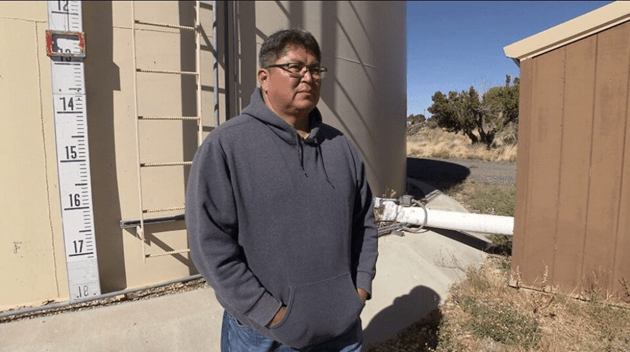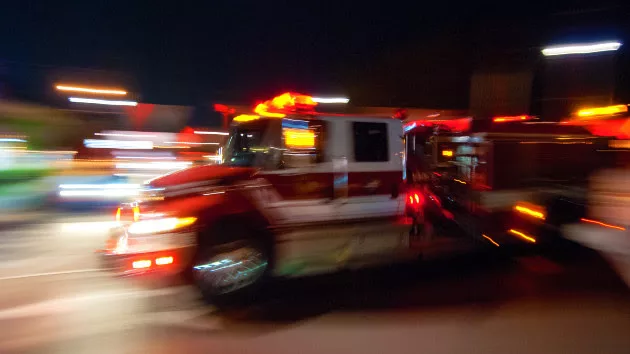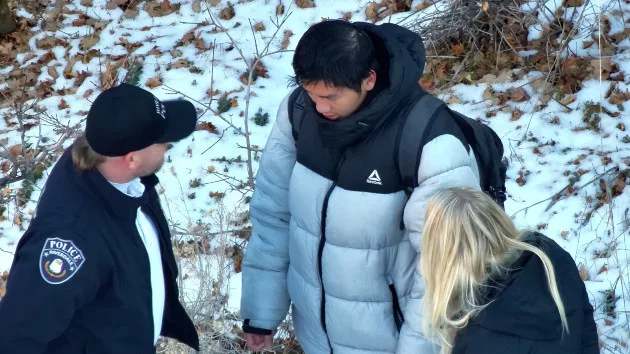
(GALLUP, N.M.) — Just miles from the site of the 1979 Church Rock Mill spill, the largest nuclear disaster in American history, uranium extraction operations could resume near the Navajo Nation. Now, Navajo leaders say the health and prosperity of their community could be in even further jeopardy.
A Canadian company is working to move forward with uranium extraction, an industry that has a lengthy history around the Navajo Nation.
“The pursuit of happiness for us is to be able to live in our communities without fear from the impact of radiation and uranium,” said Tericita Keyanna, who grew up near an abandoned uranium mine in New Mexico. “It’s been really scary, just being a mom in this area.”
‘You’d probably be angry too, right?’
More than 500 mines across the Navajo Nation once supplied uranium that helped power the U.S. Department of Defense’s nuclear arms development, including the Manhattan Project during World War II, but not a single one has been completely cleaned up in the decades since, according to the Environmental Protection Agency.
Uranium mining continued in and around the Navajo Nation after the war. In 1979, the Church Rock Mill spill occurred when a United Nuclear Corporation dam failed to hold back 94 million gallons of radioactive waste from entering the nearby Puerco River.
Larry King, a Navajo tribal member and former uranium miner, said that the Three Mile Island nuclear incident, which occurred only three months earlier in Pennsylvania, drew a national attention that they never got.
“Even the president of the United States, Jimmy Carter, made a visit to that community,” King said. “We haven’t seen anybody out here.”
King said the contamination from the spill decimated the ancestral grazing lands that provided food for his people, noting that he remembers witnessing the immediate cleanup efforts after the disaster.
“[The] method of cleanup was to hire some laborers, give them a shovel, 5-gallon buckets and start scooping all that slime that was left behind into those buckets,” King added. “It wasn’t enough.”
King said he’s still fighting for compensation.
The effects of the 1979 toxic spill into the Puerco River were detected as recently as 2015, nearly 50 miles downstream, when residents in a town called Sanders, Ariz., learned about the contamination that persisted more than three decades later.
Tommy Rock was a doctoral student when he discovered records going back 10 years that showed levels of uranium almost double the amount deemed safe by the EPA.
Still, residents say they were not notified before Rock shared his research, even though the Safe Drinking Water Act requires states to notify its citizens within 30 days of contamination being discovered.
Although tests by the Arizona Department of Environmental Quality showed that the uranium levels were almost double the amount deemed safe by the EPA, the statement ADEQ released shortly after Rock’s revelation read that “healthy adults do not need to use an alternate source water supply.”
Remediation efforts began after the state issued a compliance order as a result of Rock’s testing.
Administrators at the local elementary school said they were forced to temporarily shut down as a result of Rock’s discovery that water levels were unsafe.
Rock said community members protested, demanding answers for why they were left in the dark for over a decade.
“They’re kids. They’re not informed, and they’re being exposed to that. If it was your kid, you’d probably be angry too, right?” Rock said.
Protecting the next generation
Multiple studies have found that environmental radiation, which emits from uranium, can present an increased risk of respiratory illnesses with elevated risk of cancer and kidney diseases.
While it’s not possible to definitively connect one person’s illness to radiation exposure, many Navajo community members are deeply concerned about the risk.
Keyanna was a volunteer for the University of New Mexico’s Birth Cohort Study, which found that some pregnant mothers living in the area gave birth to newborns with elevated levels of uranium in their urine.
She says her two children struggle with their health, something she suspects is a result of early radiation exposure.
“As a mom, it is something that causes a lot of fear for me,” Keyanna told ABC News. “There’s that constant worry of whether the impacts that you’ve had to deal with all your life are impacting your children now.”
That fear is also one of the main reasons that Davona Blackhorse, who studies cancer in Native American communities, moved off the reservation with her three children.
Blackhorse says leaving her homeland was difficult because it keeps her family further away from their cultural traditions.
“It has completely stripped a lot of us from that connection that people had to the land. We’re already dealing with complex trauma,” Blackhorse said.
More extraction on the horizon?
Part of the Navajo Reservation has small plots of land on a grid that are a mix of tribal, government and private property, making up what is known as the checkerboard system.
Near one of those private properties, some residents have shifted their focus from abandoned uranium mines to the potential for future uranium extraction.
They have focused on a New Mexico property that is owned by a subsidiary of Toronto-based Laramide Resources, but surrounded by the Navajo Nation.
The company, which started exploratory drilling in February, is currently under review for state and federal permits they need to move forward with uranium production.
One requirement they face is the ability to prove that they can restore the quality of the groundwater they plan to utilize during the course of their extraction. Navajo leaders are concerned given that many in the scientific community say that water used for extraction has never been successfully restored to pre-mining conditions.
The Nuclear Regulatory Commission says that the “primary restoration goal” for any company is to return groundwater to “pre…injection levels,” but they will accept the standard set by the Safe Drinking Water Act, which allows for up to 30 micrograms of uranium per liter of water.
Laramide’s proposed operations involve a technique called in situ recovery, which, unlike traditional underground or open-pit mining, drills into an underground water source and injects solvents to strip surrounding rock of radionuclides.
The NRC defines this technique as a “primary extraction method… currently used to obtain uranium from underground.”
In an email, Laramide CEO Marc Henderson told ABC News that the technique they hope to use is “more akin to [a] water treatment plant than what most people would think of as ‘mining.’”
They currently plan to tap into the Westwater Canyon Aquifer, which serves as a fresh water source for at least 15,000 people.
Residents fear any potential contamination would exacerbate an already existing water shortage — 30% of Navajo Nation homes already do not have access to clean running water.
“You run the risk of committing a portion of your groundwater to long-term contamination,” says Chris Shuey of the Southwest Research and Information Center. “It’s too risky.”
“Laramide is a mining company,” Shuey said. “Its goal is to get uranium out of the ground, sell it to utilities to make profit.”
‘We’re ready to have a safe place to live’
To many in the Navajo Nation, the topic of uranium extraction brings up concerns about needing to relocate from their land.
James Benally, an elected Navajo community leader, says the deep mistrust in relocation comes from a long history of the U.S. government policies of forced assimilation.
“We will lose our cultural traditional teaching. We will lose our Navajo language. And we will lose our old history here,” Benally told ABC News regarding what he believes would happen if future relocations due to uranium issues are needed. “To me, we would let down our ancestors. That’s what I think.”
Benally was instrumental in organizing remediation efforts of mines for his constituents, with 88 abandoned mines near his community under a collective consideration for Superfund designation from the EPA. This designation, if granted, would bring additional funding for cleanup efforts.
“We hear a lot of times in these communities that the process is just taking too long,” Jacob Phipps of the EPA told ABC News, explaining that they have to determine the location and extent of contamination. “Our process does take a long time.”
The EPA has been the primary authority responsible for cleaning up abandoned uranium mines on the Navajo Nation since efforts began in 2008 and has since committed to cleaning up 240 mines of the over 500 that remain as part of a 10-year plan.
Keyanna’s aunt, Berth Nez, said her family has been relocated from their home near the Church Rock Mill spill site by the EPA three times since 2007.
“Relocation is losing part of yourself,” Keyanna said. “I feel very tied to this land.”
“We lost a lot of people that worked at the uranium mines,” Nez told ABC News. “They had problems, respiratory problems, cancer and all kinds of stuff. We’re ready to have a safe place to live.”
With the potential of more uranium extraction so close to the Navajo Nation, Keyanna and Nez say they want to make sure their community is protected.
“We want our future kids and grandkids all to be safe. That’s what we want,” Nez said.
Copyright © 2023, ABC Audio. All rights reserved.





